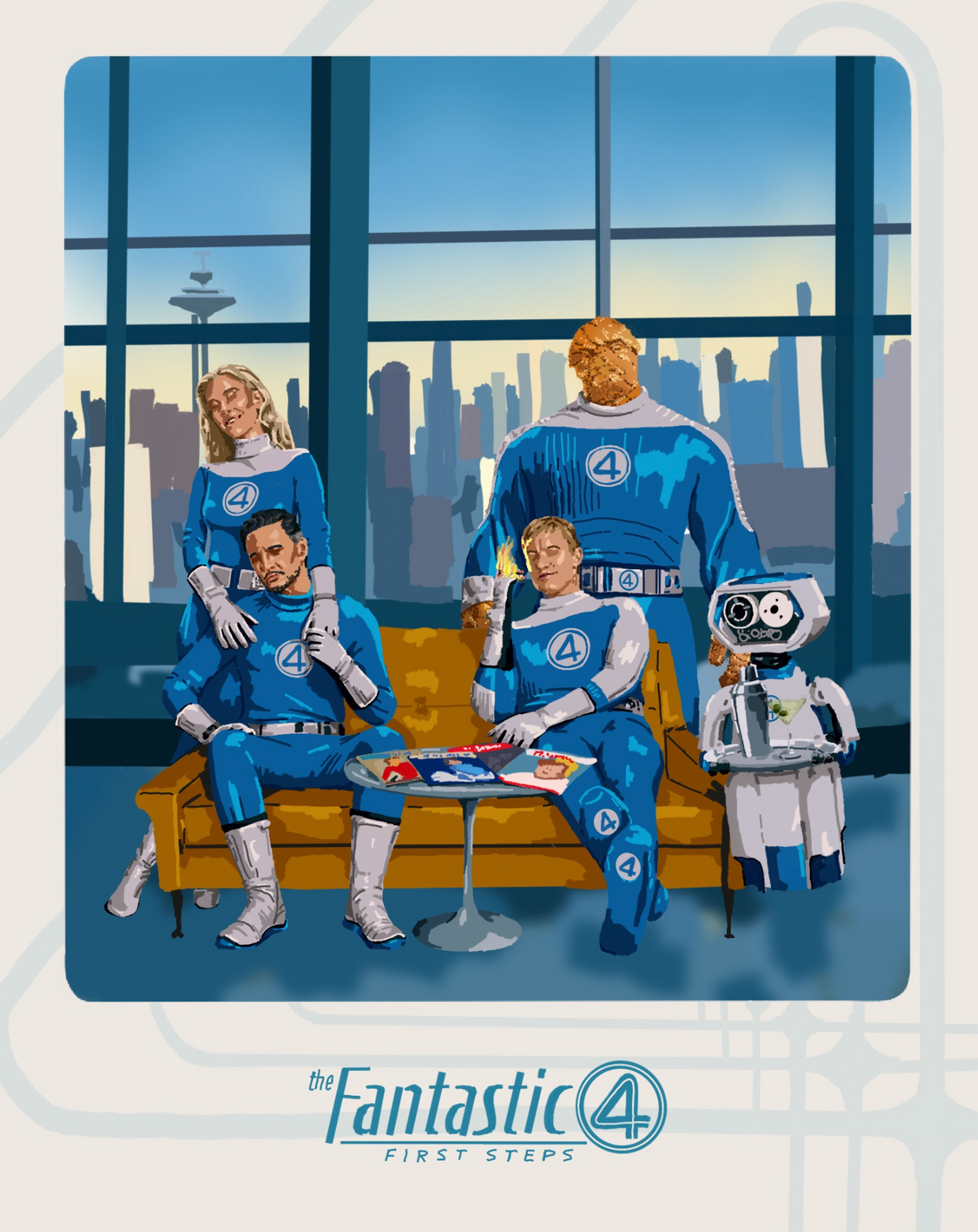Fantastic Four: First Steps (2025) Was Pretty Fantastic
Fantastic Four: First Steps creates a visually-stunning, heartwarming viewing experience featuring some writing missteps.
Reading Time: 4 minutes

The Fantastic Four—a group of superheroes composed of Mister Fantastic, Sue Storm, Human Torch, and the Thing—have been adapted into film many times since their first television series in 1967. The latest installment, Fantastic Four: First Steps (2025), has grossed $500 million globally since its release. As though it’s been breathed to life from a comic book, Fantastic Four: First Steps is both visually interesting and charming, departing from the traditional, hyper-realistic superhero movies of recent years that attempt to assimilate superheroes into modern society.
True to its name, Fantastic Four: First Steps features the iconic Fantastic Four: Mister Fantastic (Pedro Pascal), Sue Storm (Vanessa Kirby), Human Torch (Joseph Quinn), and the Thing (Ebon Moss-Bachrach). The beginning scenes depict a flashback to an experimental space mission, during which the exposure to cosmic radiation earned the Fantastic Four their superpowers. The film returns to the present to show that the superhero team has established itself as protectors of New York City, having a major fan base and even an animated TV show. That said, the city—and the rest of the world, for that matter—is far from safe. A woman from outer space (Julia Garner) descends upon New York, claiming that Galactus (Ralph Ineson) has chosen Earth to be consumed, its safety only guaranteed under one condition: Mister Fantastic and Sue Storm give Galactus their child. Unwilling to do so, the Fantastic Four gear up to save the planet on their own terms, peacefully or not.
Modern superhero films, including Spiderman: Far From Home (2019), Shang-Chi and the Legend of the Ten Rings (2021), and Avengers: Endgame (2019), tend to place themselves in worlds or timelines similar to our own, attempting to capture the sense of reality in street train cars and the grittiness of city streets. This makes Fantastic Four: First Steps stand out; one of its most noticeable characteristics is its romanticized, light-blue aesthetic reminiscent of 1960s style. Unlike its contemporaries that bring the superheroes to viewers’ daily lives, Fantastic Four: First Steps entices its audience into the Fantastic Four’s Earth-828 with its beautiful visuals while simultaneously connecting the film to the original Fantastic Four comic series that debuted in 1961. This aesthetic choice is thorough and well-done; from the sleek, retro-futurist kitchen design to the characteristically-blue Fantasti-car, each detail allows viewers to fully immerse themselves in the world of the superhero team.
The costume design, in particular, adds both character and warmth to the film. While their predecessors (The Fantastic Four films from 2015, 2007, 2005, and 1994) opted for dark indigo suits, the team behind Fantastic Four: First Steps chose a lighter sky-blue, reminiscent of the 1967 TV show while simultaneously evoking a childlike innocence, a fitting color for the family that the film portrays. The ribbed knit texture of the suits mirrors that of a sweater that one can buy at a local clothing shop. This combination of nostalgic color and common textures appeals to the hearts of the film’s viewers by bringing a sense of familiarity, bridging the gap between the fantastical subjects on-screen and the everyday lives of the audience.
Evidenced by its immersive effect, the technological production of this film is also top-notch. With its realistic stone textures, smooth motion-capture animation, and synced, stone-rolling sound effects, the Thing’s form was masterfully done. Galactus, a titanic figure known as the “Devourer of Worlds,” was also portrayed with noticeable care and detail displayed, from the wrinkles on his face to his grand, mechanically-styled throne.
Featuring a star-studded cast, the majority of the performances were well-executed, only being limited by the scope of the film’s script. Quinn as Human Torch added much-needed comedic relief and a variety of emotions for viewers to connect with in the film, in spite of the character’s amorphous personality. Pascal, on the other hand, seemed to lack depth in his portrayal of Mister Fantastic, or Reed Richards; his character was reduced to a “worried family man” and lacked additional character development. That being said, Pascal’s performance could also be attributed to poor writing that did not seek to ground the character’s stories, rather than the actor himself.
The writing, however, succeeded in humanizing the Fantastic Four within the film’s premise itself. The reason that the Fantastic Four begin to fight Galactus is because they refuse to exchange Mister Fantastic and Sue Storm’s child for Earth’s preservation. This decision is incredibly human in its loyalty to family, as well as in its flawed nature: the belief that one baby’s life is worth risking the lives of billions. The film brings the plot close to home; instead of it being a superheroes’ fight, it is a family’s fight to protect each other.
As a whole, Fantastic Four: First Steps was a visual triumph with its top-notch CGI, costume design, and period theming. These aspects of the film compound to create a movie that gets to the humanity of this team of superheroes, though its effectiveness is slightly diminished by poor character writing. In spite of taking place in an alternate universe, Fantastic Four: First Steps is worth a watch as it presents a story that rings true for many: the attempt to protect the ones you love, even when it seems like the whole world—or a giant god-like man—is against you.
